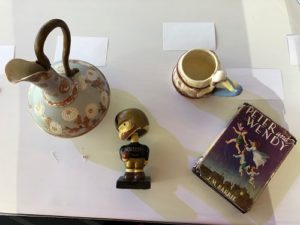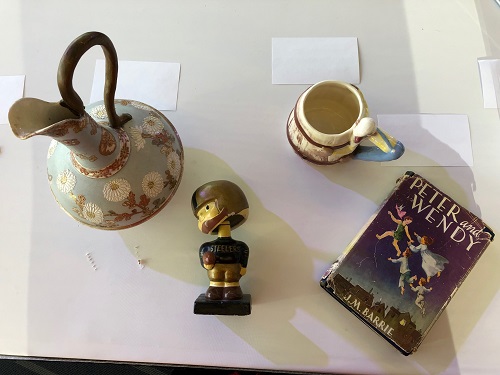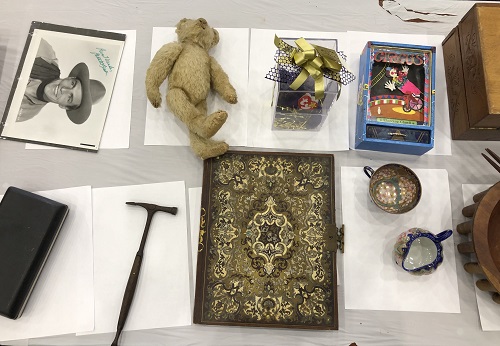
Here are three secrets to help you learn how to sell like a seasoned antiques dealer. The tips and tricks of antiques dealers will show you how to sell everything from Asian art to zebra-skinned carpets.
1. Avoid One-Stop Selling
It is important to remember that if you want one stop selling, read auction selling tips, then you give up a lot of the piece’s value for that convenience of not selling off pieces to multiple buyers or marketing them individually online. Also, if you want to liquidate everything quickly or all of it at the same time of the year, read tips on seasonal selling, you will probably lose money. I know it sounds attractive to just get it done, but if the monetary results are a concern, then move slowly. Certain objects sell better in certain places–Revolutionary war memorabilia better in Boston rather than in Nevada–and certain objects sell better during certain seasons of the year– autographed baseballs in the summer or around the World Series.
This blog was prompted by my work guiding the adult children of a deceased American antiques dealer. A child in this family contacted my office to learn the value of antique furniture and artwork that belonged to their parents’ antiques business. The objects were inherited by a large group of children, none of whom work in the antiques business. The big family of children are now in disagreement over the pieces and how to move forward with valuable items that they don’t know anything about. They say they don’t know about how to market them for sale either.
The group of children hastily sold some of the items to a dealer friend of the family shortly following the death of their parents even though their parents had advised them not to sell the items to this family friend and fellow dealer. It is wise to note that, if possible, selling anything of significant value shortly after the death of a loved one is never a good idea. If you can wait and deal with the grief before moving ahead with a sale, that will always be to your benefit.
So, now the children are disappointed in the deal they made and sorry that they didn’t heed their parents’ warning about getting too little for the antiques even from a family friend and fellow dealer.
One child wanted to get an honest unbiased appraisal from a non-dealer and non-auction house appraiser while the other two children wanted to sell everything quickly to one buyer. The children accepted the first offer they got and now they have learned that the buyer re-sold the antiques for double and triple the amount the children got paid. The children now know that they should have gotten an unbiased appraisal. They don’t want to make the same mistake again. Instead of getting expert advice or honest appraisals first, they sold most of the pieces to someone who paid them about 10% of their actual retail value. They now realize the pieces were worth more and want to know how to sell what’s left. Read another true story to understand the 10% rule and how it affects you when selling.
2. Antiques Dealers get Appraisals
Most dealers who have success in the antiques market get appraisals so they can view comparable sales records where similar pieces have sold. This is how seasoned antiques dealers benefit from working the markets. They make an unbiased decision by calling in an expert who can give them an appraisal. Most dealers will tell you that they want an unbiased appraisal so they can price and market their pieces in order to bring home the most money for a particular work of art or antique. They know that they are not the best researchers and they know that they will be able to work smart within the market if they have a correct identification, an analysis of the current market showing comparable sales records worldwide, and an expert’s appraisal document.
I have prepared appraisals for many clients–some well-known antiques dealers and auction houses–because they did not have the time, expertise, or knowledge of that type of object to develop an unbiased appraisal. Some have told me that they were not able to analyze the nuances of the market for that particular item in the same way an expert appraiser and non-seller would. The dealers knew that having the unbiased appraisal document from someone like me with a Ph.D. in the field will attract sellers to their sale and will help an antique sell for a higher value.
Buyers like to see what the market analysis looks like before they purchase a work of art or rare and costly antique object. They like to see the identification method and appraisal documentation of condition, medium, date, provenance, artist’s biographical information, appraisal analysis, comparable sales records, etc. There is a reason why experts in the field want appraisals and they want them from expert appraisers not just fellow dealers.
3. Leave it Alone
No, I don’t mean “I want to be alone” like those actresses of the golden age of Hollywood use to say, I mean don’t be overzealous with your aging art or antiques. Don’t at first glance start repairing, restoring, touching up, or re-framing, read framing tips, that antique object that you ultimately want to sell. In short, don’t clean it or restore it thinking that you’ll make it better than it is. And replacing that frame may mean that you have replaced a valuable part of the overall work of art. Don’t just ditch the frame, it may have value and it may be an integral part of the work of art.
I have had a long list of clients who have decided to clean that painting or wash that glass pitcher only to damage it beyond repair and reduce its value. I remember a client who brought me a lovely pair of 18th Century American family portraits that were beyond repair after he looked up “how to clean a painting” on the internet and ended up scrubbing the painting all the way down to the raw canvas. He severely reduced both paintings’ value.
Another client decided to clean her great, great, great grandmother’s hand cut glass pitcher from the 1880s and when she submerged it into a sink of hot water, it cracked on impact. Most dealers will only surface dust or gently clean objects and they bring in professional restorers when the project is over their skill level. If you are looking for a professional restorer, ask your local museum for a referral. When it comes to cleaning, restoration, or reframing, less is more and in some situations, doing nothing is the best choice.
Read the ways I can help you with an unbiased and honest appraisal.




